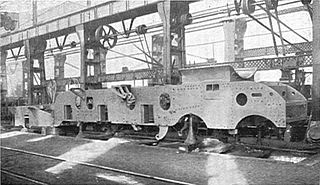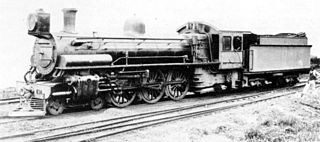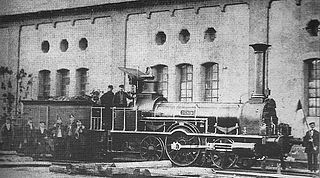
A steam locomotive is a locomotive that provides the force to move itself and other vehicles by means of the expansion of steam. It is fuelled by burning combustible material to heat water in the locomotive's boiler to the point where it becomes gaseous and its volume increases 1,700 times. Functionally, it is a steam engine on wheels.

A tank locomotive or tank engine is a steam locomotive that carries its water in one or more on-board water tanks, instead of a more traditional tender. Most tank engines also have bunkers to hold fuel; in a tender-tank locomotive a tender holds some or all of the fuel, and may hold some water also.
Rail terminology is a form of technical terminology. The difference between the American term railroad and the international term railway is the most significant difference in rail terminology. These and other terms have often originated from the parallel development of rail transport systems in different parts of the world. In English-speaking countries outside the United Kingdom, a mixture of US and UK terms may exist.

Main components found on a typical steam locomotive include:

A locomotive frame is the structure that forms the backbone of the railway locomotive, giving it strength and supporting the superstructure elements such as a cab, boiler or bodywork. The vast majority of locomotives have had a frame structure of some kind. The frame may in turn be supported by axles directly attached to it, or it may be mounted on bogies (UK) / trucks (US), or a combination of the two. The bogies in turn will have frames of their own.

The GWR 4100 Class was a class of steam locomotives in the Great Western Railway (GWR) of the United Kingdom.

The SR West Country and Battle of Britain classes, collectively known as Light Pacifics or informally as Spam Cans, are air-smoothed 4-6-2 Pacific steam locomotives designed for the Southern Railway by its Chief Mechanical Engineer Oliver Bulleid. Incorporating a number of new developments in British steam locomotive technology, they were amongst the first British designs to use welding in the construction process, and to use steel fireboxes, which meant that components could be more easily constructed under wartime austerity and post-war economy.

Under the Whyte notation for the classification of steam locomotives by wheel arrangement, a 4-6-2+2-6-4 is a Garratt or Union Garratt articulated locomotive using a pair of 4-6-2 engine units back to back, with the boiler and cab suspended between them. The 4-6-2 wheel arrangement of each engine unit has four leading wheels on two axles, usually in a leading bogie, six powered and coupled driving wheels on three axles, and two trailing wheels on one axle, usually in a trailing truck. Since the 4-6-2 type is known as a Pacific, the corresponding Garratt type is usually known as a Double Pacific.

The Dean Single, 3031 Class, or Achilles Class was a type of steam locomotive built by the British Great Western Railway between 1891 and 1899. They were designed by William Dean for passenger work. The first 30 members of the class were built as 2-2-2s of the 3001 Class.

Under the Whyte notation for the classification of steam locomotives by wheel arrangement, 2-6-2+2-6-2 is an articulated locomotive using a pair of 2-6-2 power units back to back, with the boiler and cab suspended between them. The 2-6-2 wheel arrangement has a single pair of leading wheels in a leading truck, followed by three coupled pairs of driving wheels and a pair of trailing wheels in a trailing truck. Since the 2-6-2 type was often called the Prairie type, the corresponding Garratt and Modified Fairlie types were usually known as a Double Prairie.

The SR Merchant Navy class is a class of air-smoothed 4-6-2 (Pacific) steam locomotives designed for the Southern Railway by Oliver Bulleid. The Pacific design was chosen in preference to several others proposed by Bulleid. The first members of the class were constructed during the Second World War, and the last of the 30 locomotives in 1949.

The South African Railways Class 19C 4-8-2 of 1935 was a steam locomotive.

The South African Railways Class 16E 4-6-2 of 1935 is a class of passenger steam locomotive.

The South African Railways Class 15A 4-8-2 of 1914 was a steam locomotive.

The South African Railways Class 12 4-8-2 of 1912 was a steam locomotive.

The South African Railways Class 10B 4-6-2 of 1910 was a steam locomotive from the pre-Union era in Transvaal.

The South African Railways Class 10A 4-6-2 of 1910 was a steam locomotive from the pre-Union era in Transvaal.

The South African Railways Class 3 4-8-2 of 1909 was a steam locomotive from the pre-Union era in the Colony of Natal.

The South African Railways Class GM 4-8-2+2-8-4 of 1938 was an articulated steam locomotive.

The steam locomotivess with operating numbers 1–8 and 21 belonged to the Palatinate Ludwig Railway. They were the first locomotives built for this company. The locomotives manufactured from 1846 onwards were taken out of service by 1883.



















